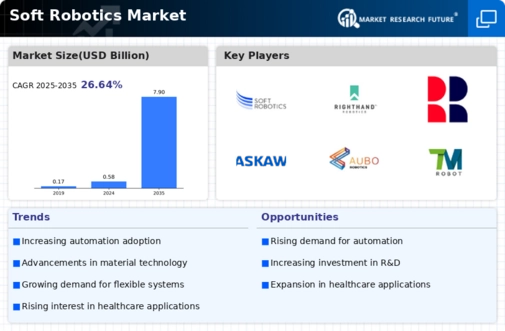Market Analysis
In-depth Analysis of Soft Robotics Market Industry Landscape
Soft robotics, which is distinguished using flexible and deformable resources, has become increasingly popular due to its ability to provide a special set of features not present in conventional rigid robotics. The need for more secure human-robot interactions, the requirement for flexible robotic solutions, and the rise in automation in a variety of industries all influence the market dynamics. The need for safer human-robot cooperation is one of the main factors propelling the soft robotics market. Because of their inflexible construction, regular industrial robots have frequently been restricted to regulated surroundings, which has limited their ability to interact with people. Because soft robotics is flexible and obedient, robots can work side by side with humans without endangering them. This has led to a rise in usage in industries including manufacturing, wherein soft robotic exoskeletons help people with movement problems, and healthcare, where they enable human workers to collaborate with robotic counterparts. Furthermore, new opportunities for automation across industries have been made possible by the adaptability of soft robots. Soft robots are highly adaptable to intricate and chaotic settings, which makes them ideal for jobs requiring quick reflexes and dexterity. For example, soft robotic grippers in agriculture may handle fruits gently without breaking them, and soft robotic platforms in search and rescue can easily maneuver across difficult terrain. Due to its versatility, soft robots have been integrated into a wide range of industries, propelling the market's expansion. The need for lightweight and compact robotic systems has added to the fluid market situation in addition to security and adaptability. Soft robotics, which are frequently made of lightweight components and parts, are ideal for uses where weight and space restrictions are important considerations. This is especially true in the realm of medical automation, where surgeons may perform minimally invasive procedures with greater precision and agility in limited locations thanks to the use of soft robotic equipment. Novel materials that combine durability and flexibility are being investigated by academics and businesses to create soft robots that will last longer and perform better. Furthermore, the use of sophisticated sensors and algorithms for machine learning amplifies the self-sufficiency and judgment of soft robotic systems. Associations between corporate companies and educational organizations becomes increasingly important as the soft robotics industry continues to expand. Soft robotics is a multidisciplinary area that requires knowledge from computer science, materials science, engineering, and other disciplines.









Leave a Comment